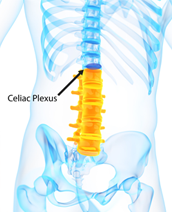Celiac Plexus Blocks
 A celiac plexus block is an injection of local anesthetic into or around the celiac plexus of nerves that surrounds the aorta, the main artery in the abdomen. Normally these nerves control basic nerve functions. In certain conditions, these nerves can carry pain information from the gut or abdominal organ tissues back to the spinal cord and brain.
A celiac plexus block is an injection of local anesthetic into or around the celiac plexus of nerves that surrounds the aorta, the main artery in the abdomen. Normally these nerves control basic nerve functions. In certain conditions, these nerves can carry pain information from the gut or abdominal organ tissues back to the spinal cord and brain.
What is the purpose of a celiac plexus block?
A celiac plexus block is performed to block the celiac plexus of nerves that go various organs and parts of the abdomen. This may in turn reduce pain in the abdomen. It is done as a part of the treatment of Chronic Pancreatitis and other types of Chronic Abdominal Pain.
How long does the celiac plexus block take?
The actual injection takes from 10 to 30 minutes.
What is actually injected?
The injection consists of a local anesthetic. On occasion, epinephrine, clonidine or a steroid medication may be added to prolong the effects of the celiac plexus block.
Will the celiac block hurt?
The procedure involves inserting a needle through skin and deeper tissues. So, there is some pain involved. However, we may numb the skin and deeper tissues with a local anesthetic using a very thin needle before inserting the actual block needle. Most of the patients also receive intravenous sedation that makes the procedure easier to tolerate.
Will I be “put out” for the celiac plexus block?
No. This procedure is done under local anesthesia. Most of the patients also receive some sedation, which makes the procedure easy to tolerate. The amount of sedation given generally depends upon the patient tolerance. Some patients may have enough sedation that they have amnesia and may not remember all or parts of the procedure.
How is the celiac plexus block performed?
It is done with the patient lying on stomach. The patients are monitored with EKG, blood pressure cuff and an oxygen-monitoring device. The celiac plexus block is performed under sterile conditions. The skin on back is cleaned with antiseptic solution and the skin is then numbed with a local anesthetic. Then X-ray is used to guide the needle or needles into the proper position along the outside of the spine. Once in place, a test dose of dye is used to confirm that the injected medication will spread in an appropriate area. If this is okay, the injection takes place gradually over several minutes. The physician will use the X-ray to evaluate the spread of the injected medication. When a sufficient area is covered, the injection will be over. When done, the needle is removed and a Band Aid is applied.
What should I expect after the celiac plexus block?
Immediately after the injection, you may feel your abdomen getting warm or feeling a bit different. In addition, you may notice that your abdominal pain may be gone or quite less. You may also notice some temporary weakness or numbness in the abdominal wall or leg, although this is actually not a desired effect of a celiac plexus block.

